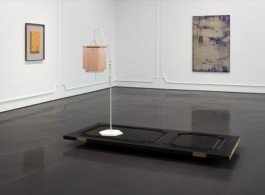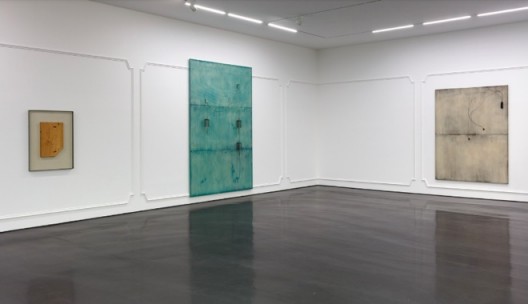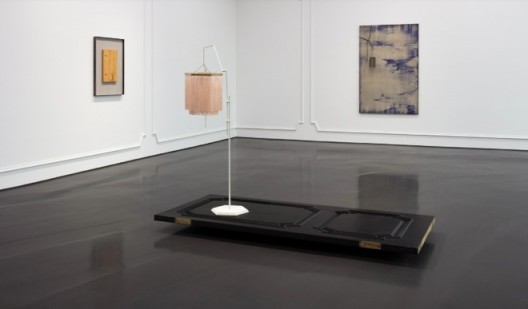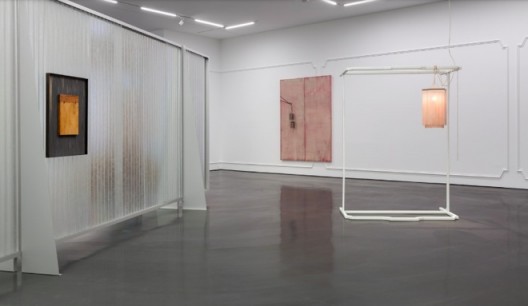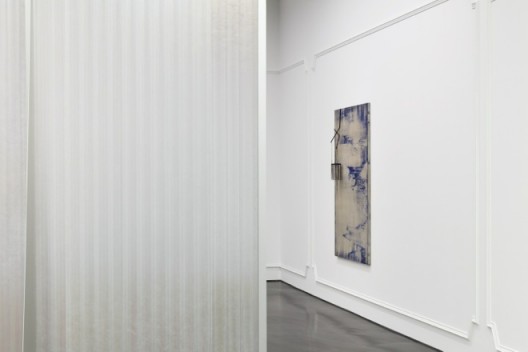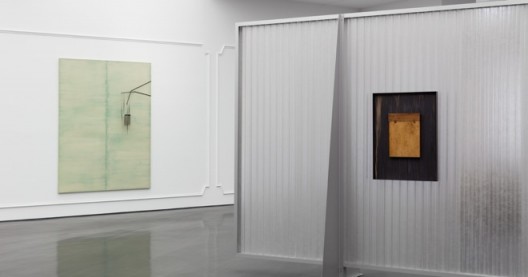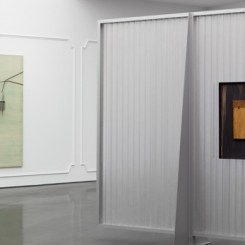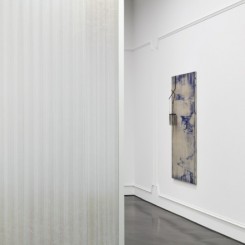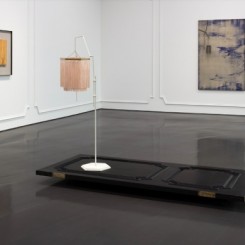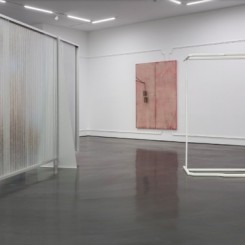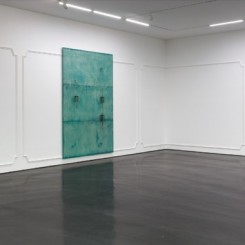Esther Schipper
Esther Schipper is pleased to announce The Light Pours Out, Martin Boyce’s first solo exhibition with the gallery.
Martin Boyce has subtly transformed the gallery space by creating a system of moldings that cover the walls, turning their surface into sculptural settings and formal frames for his sculptures. Presenting new works from his series of painted panels of perforated steel with attached metal elements, large-scale screens, and works from his series of Jesmonite panels, the artist continues his hybridization of distinct traditions of art, architecture, design, and urbanism—both Western and Eastern, modernist and historical.
Taking its shape from the 1925 Concrete Trees by the brothers Jan and Joël Martel which since 2005 have functioned as “a lexicon of shapes and forms” for the artist, the moldings create an entablature that invokes both the history of architectural ornamentation and the 18th and 19th century’s predilection for domestic adornments. In this context, the molding in particular draws attention to the history of exhibitions—the pattern of rectangles imposes a new rhythm on the space, literally constituting frames (traditionally used for paintings), while at the same time representing their conceptual power as markers of signification.
In a further nod to the artist’s ongoing exploration of painting by other means—interweaving qualities associated with sculpture and painting, three-dimensional object and picture plane, solidity and transparency—a series of works made from colored perforated steel panels with elements consisting of chains and small lanterns punctuate the sections formed by the molding. (When the panels intersect the molding, its the formal and conceptual function as framing device becomes even more apparent.) Painted and stained, the monochromatic panels—works consist of one, two or three—have a luminous quality. The color has a fluidity reminiscent of ink or watercolor, staining the perforated surface with delicate cascading pattern.
In the context of Boyce’s interest in Chinese art, the works bring to mind the characteristic compositions of Chinese painting of mountainous landscapes. The attached lanterns and chains reinforce such an association: a recurring motif in Boyce’s work, the metal lanterns refer both to the characteristic shape of Chinese lamps and lanterns and to those based on his engagement with the Martel brothers’ trees. The charged balance between sparseness and iconographic motif of the single sculptural component of each work, further recalls a stylistic device developed by traditional Chinese and Japanese painting practice.
At the same time, the sculptural incidents blend industrial and organic associations: the discolored metal chains bear witness to a process of decay or dilapidation (as such chains undergo outside) while, as often in Boyce’s work, the shapes take on a naturalistic character, as their fluid forms also recall those found in nature (such vines, delicate branches or the languid lines of willow trees).
Two sculptures—one that pairs a standing lamp on a painted door raised slightly above the floor, as if floating in parallel to it, and another that includes a lamp suspended from a large-scale metal frame recalling the head- and footboard of a bed standing on its head—continue this entanglement of organic, anthropomorphic, and machine associations.
Two large-scale free-standing works function both as dividers and frames, a form Boyce has employed as part of his creation of hybrid architectural landscapes to highlight the polysemy of screens as boundaries, openings, and markers of liminal spaces. Their diaphanous quality—the surface is made from semi-transparent glass-reinforced plastic mounted over a rectangular metal frame—emphasizes their function as conceptual thresholds.
Large-scale gates or screens that structure Boyce’s urban landscapes, creating parcours or individuated pockets of space, have combined architectural and urban references. While fences, gates, windows, composed of upturned benches, metal grilles, or chains, that recalled the temporary constructions of low-cost housing or shantytowns have been a recurring motif, these new works further articulate the implicit debt to the sliding paper walls of traditional Japanese architecture. At the same time, the translucency invokes the effect of curtains paradoxically shielding the large glass windows of modernist buildings, blurring what was conceived as an architecture of transparency.
Martin Boyce has reworked and reformulated iconic design objects, developing his own pictorial language based on a reading of the formal and conceptual histories of art, design, architecture and urban planning. Boyce’s exhibitions often take the form of enchanted landscapes that appear inhabited by slightly laconic witnesses of past urban development programs but also imbue the formal vocabulary of contemporary urbanism with moments of unexpected tenderness and beauty.
BIOGRAPHY
Martin Boyce was born 1967 in Hamilton, Scotland. He studied at Glasgow School of Art and at California Institute for the Arts. Boyce currently holds a professorship at the HfBK in Hamburg. He lives and works in Glasgow.
The artist received the Turner Prize in 2011. In 2009, Boyce represented Scotland at the 53rd Venice Biennale. He participated in the Skulptur Projekte Münster in 2007.
Boyce has exhibited extensively. His institutional solo exhibitions include: Hanging Gardens, LUXELAKES·A4 Art Museum, Chengdu (2018); Remembered Skies, Clore Gallery Courtyard, Tate Britain (2018); Do Words Have Voices, Tate Britain, London (2016); Spook School, CAPRI, Düsseldorf (2016); Martin Boyce, Museum für Gegenwartskunst, Basel (2015); Martin Boyce: When Now is Night, Rhode Island School of Design, Providence (2015); Study: Eyes – Martin Boyce, David Roberts Art Foundation, London (2013), and a commission for the Massachusetts Institute of Technology, Cambridge, Massachusetts (2010).
Recent group exhibitions include: She sees the shadows, MOSTYN David Roberts Art Foundation, Cardiff (2018 – ongoing); paperwork, Haubrok Foundation, Berlin (2018); ISelf Collection: The Upset Bucket, Whitechapel, London (2017-2018); I am not my target audience, Kunsthaus Dresden, Städtische Galerie für Gegenwartskunst, Dresden (2017); Mentally Yellow (High Noon), Kunstmuseum Bonn, and Städtische Galerie im Lenbachhaus, Munich (2017); L’Esprit du Bauhaus, L’Objet en Question, Musée des Arts Décoratifs, Paris (2016).
His work is represented in the collections of the Museum of Modern Art, New York; Tate, London; Museum für Moderne Kunst, Frankfurt; British Council, London; Gallery of Modern Art, GoMA, Glasgow; Rhode Island School of Design, Providence; Massachusetts Institute of Technology List Visual Arts Center, Cambridge, MA; National Gallery of Victoria, Melbourne; LACMA, Los Angeles; Henry Moore Institute, Leeds; Scottish National Gallery of Modern Art, Edinburgh; Carnegie Museum of Art, Pittsburgh, among other institutions worldwide.

